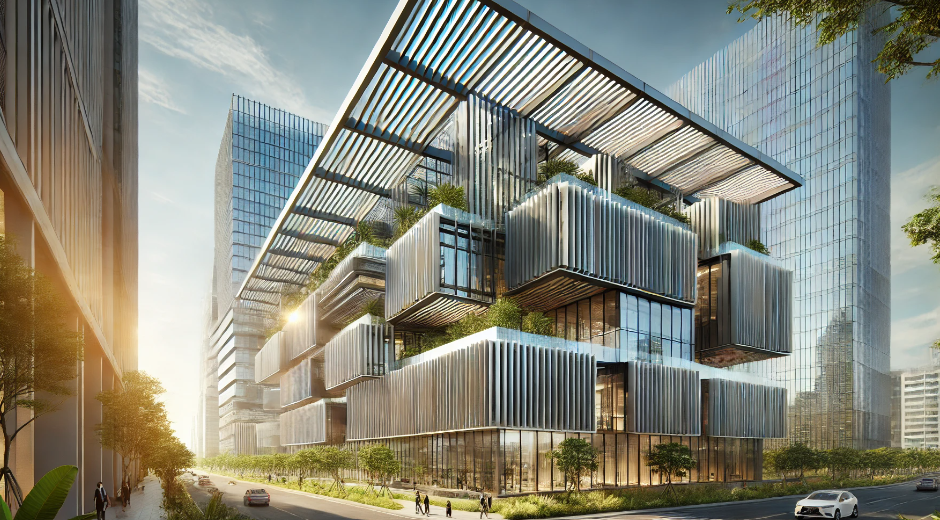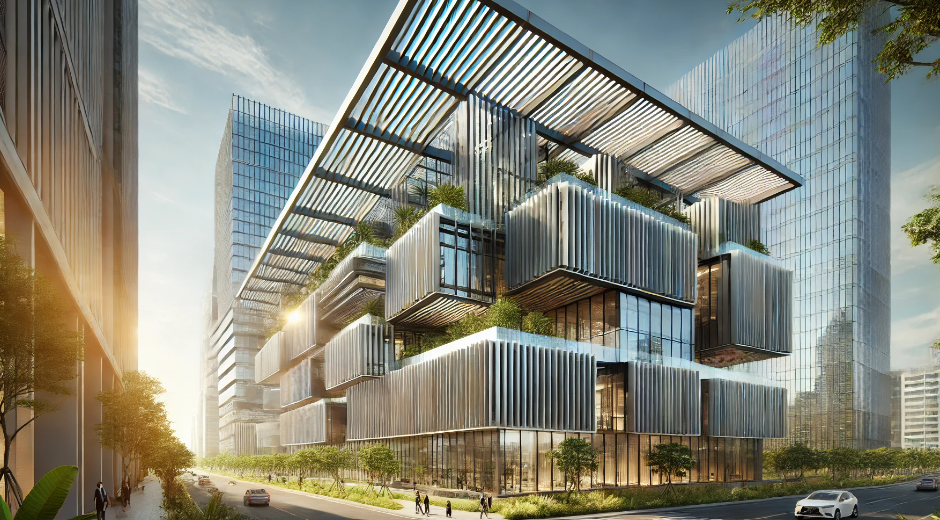![]()
As urban landscapes evolve, modern architectural designs demand a balance between aesthetic appeal, energy efficiency, and functionality. Structurally glazed louvers have emerged as an innovative solution to meet these needs, especially in rapidly growing regions like Eastern India, including cities such as Kolkata, Bhubaneswar, Ranchi, Durgapur, and Siliguri. These louvers not only enhance building exteriors but also provide critical functionalities such as solar shading and ventilation. This blog delves into the significance of structurally glazed louvers, their application in the Eastern Indian context, and the financial and environmental benefits they offer.

What are Structurally Glazed Louvers?
Structurally glazed louvers are architectural elements integrated into a building’s glazing system. They serve multiple purposes: controlling solar heat gain, improving natural ventilation, and offering a sleek, modern design aesthetic. They can be crafted from tempered or laminated glass and often come with a range of finishes, including tinted, reflective, or low-e coatings.
These louvers can be fixed or motorized, making them adaptable to various architectural needs. They are designed to maximize energy efficiency while enhancing the visual appeal of a building.
The Rise of Structurally Glazed Louvers in Eastern India
The demand for structurally glazed louvers has seen a significant rise in Eastern Indian cities. This region faces hot and humid climates, making solar control and ventilation crucial in both residential and commercial buildings. Here’s a look at how these louvers are changing the architectural landscape:
- Kolkata: As the largest metropolitan city in Eastern India, Kolkata has seen a boom in IT parks, malls, and high-end residential complexes. Structurally glazed louvers are increasingly being adopted in these buildings to reduce solar heat gain and minimize cooling loads. For example, modern office spaces in Salt Lake Sector V and upscale residential projects in New Town have started incorporating these louvers for their energy-efficient benefits.
- Bhubaneswar: Known for its emerging IT and real estate sectors, Bhubaneswar’s commercial buildings and IT parks are adopting structurally glazed louvers to cut energy costs and improve indoor comfort.
- Siliguri and Durgapur: These rapidly developing cities are also catching on to this trend, as property developers seek to enhance the energy efficiency of both residential and commercial buildings.
Features and Benefits
Structurally glazed louvers provide several key advantages:
- Energy Efficiency: By controlling solar heat gain and facilitating natural ventilation, structurally glazed louvers reduce reliance on air conditioning systems. This results in significant energy savings, making them an environmentally responsible choice.Example Calculation: Assume a commercial building in Kolkata uses air conditioning systems to cool a total area of 1,000 square meters. If installing structurally glazed louvers reduces solar heat gain by 20%, leading to a 10% reduction in cooling load, the total annual energy consumption savings can be calculated as follows:
- Total cooling load: 150,000 kWh/year
- Energy savings: 150,000 kWh × 10% = 15,000 kWh/year
- Annual cost savings: 15,000 kWh/year × ₹6/kWh = ₹90,000/year
- Enhanced Aesthetic Appeal: These louvers provide a sleek, modern look that elevates the architectural beauty of a building. In Eastern Indian cities like Kolkata and Ranchi, where urban design is rapidly evolving, structurally glazed louvers add a contemporary touch to both commercial and high-end residential buildings.
- Climate Adaptability: The varying climate across Eastern India makes structurally glazed louvers a versatile solution. They help reduce heat gain in hotter months and allow for increased ventilation in more humid conditions.
- Durability: Made from tempered or laminated glass, these louvers are built to withstand extreme weather conditions, making them suitable for the unpredictable weather patterns seen in Eastern India.
Financial and Environmental Impact
While structurally glazed louvers might require a higher initial investment, their long-term financial benefits are significant, particularly in reducing energy costs.
Glass Glazed Louvers: A Transparent Solution for Modern Buildings
Glass glazed louvers, a variation of structurally glazed louvers, offer increased transparency, allowing more natural light while maintaining privacy and reducing glare. These louvers are particularly popular in retail spaces and public buildings across cities like Kolkata and Bhubaneswar.
Key Features:
- High Transparency: Glass glazed louvers allow maximum daylight, reducing the need for artificial lighting and lowering electricity bills.
- Adjustable Designs: These louvers can be customized to control the amount of light and air entering a space.
- Durability: Like structurally glazed louvers, they are made from tempered or laminated glass, offering long-lasting performance.
Local Manufacturers in Eastern India
Several manufacturers in Eastern India specialize in creating high-quality, structurally glazed and glass glazed louvers. Companies like Intext Creative Solutions, based in Kolkata, are leading the way in providing durable and aesthetically pleasing louvers that meet the region’s architectural needs.
In addition to Intext Creative Solutions, other players like Saint-Gobain India and Asahi India Glass offer a range of customizable glass louver solutions to cater to both commercial and residential projects.
Structurally Glazed Louvers: A Modern Solution for Sustainable and Aesthetic Architecture
In today’s rapidly evolving architectural landscape, the balance between aesthetics, functionality, and sustainability is crucial. One such innovation that perfectly blends these aspects is structurally glazed louvers. These louvers not only enhance the building’s façade with a sleek and modern look but also contribute to energy efficiency by optimizing natural light and ventilation.
In regions like Eastern India—cities such as Kolkata, Bhubaneswar, Siliguri, and Guwahati—where the climate is a mix of high humidity and intense sunlight, these louvers provide the perfect solution. This blog explores the benefits, applications, and calculations related to structurally glazed and glass-glazed louvers, particularly focusing on how they fit into the growing architectural demands of Eastern Indian cities.
What Are Structurally Glazed Louvers?
Structurally glazed louvers are an architectural feature integrated directly into the glazing systems of a building. Unlike traditional louvers, which are fixed externally, structurally glazed louvers are seamlessly incorporated into the building’s glass framework. These systems combine the functional benefits of traditional louvers with the aesthetic appeal of modern glass facades.
Key Features of Structurally Glazed Louvers
- Seamless Aesthetic Integration
Structurally glazed louvers offer a clean, uninterrupted surface, enhancing the building’s overall appearance. With clear, tinted, or reflective glass options, these louvers blend effortlessly into the design, giving a contemporary touch. - Energy Efficiency
In cities like Kolkata, where summer temperatures can soar and humidity levels are high, managing solar heat gain becomes essential. Structurally glazed louvers help control the amount of sunlight that enters a building, thus reducing cooling requirements and saving energy. - Improved Ventilation and Shading
These louvers provide natural ventilation while shading the building’s interiors from direct sunlight. This leads to a more comfortable indoor environment without relying heavily on artificial air conditioning. - Durable Materials
Typically made from tempered or laminated glass, structurally glazed louvers are highly durable and resistant to weathering. They are designed to withstand extreme conditions, including heavy rainfall, strong winds, and high humidity—conditions often experienced in Eastern Indian cities.
Why Structurally Glazed Louvers Are Perfect for Eastern India
Eastern India, particularly cities like Kolkata, Bhubaneswar, Guwahati, and Durgapur, experiences a hot and humid climate with frequent monsoon rains. Structurally glazed louvers help mitigate these challenges by providing enhanced ventilation, reducing heat gain, and maintaining a modern architectural appeal.
In commercial hubs such as Salt Lake City in Kolkata or Info Valley in Bhubaneswar, where energy efficiency and aesthetic appeal are critical, these louvers play a vital role. Additionally, residential buildings in emerging cities like Siliguri are increasingly adopting this modern solution to keep up with the growing architectural trends.
Application in Residential and Commercial Buildings
Structurally glazed louvers are versatile and can be adapted to various building types:
- Commercial Complexes and Office Buildings
Many office complexes and shopping malls in Kolkata, such as Quest Mall and Acropolis Mall, have started using structurally glazed louvers for energy efficiency. These louvers reduce the building’s reliance on artificial cooling systems by optimizing natural ventilation and light control. - Residential Projects
In high-end residential projects in cities like Durgapur and Siliguri, homeowners and developers are now adopting structurally glazed louvers not only for their aesthetic value but also for practical benefits like better airflow, privacy, and heat control. - Public Buildings and Cultural Centers
Museums, libraries, and public buildings across Eastern India can benefit from these louvers. By incorporating them into the façade, these structures can reduce energy costs, improve natural lighting, and enhance the visitor experience.
Mathematical Examples to Illustrate Energy Savings
1. Solar Heat Gain Calculation:
Given:
- Window Area = 50 square meters
- SHGC (Solar Heat Gain Coefficient) = 0.3
- Incident Solar Radiation = 850 W/m²
Solar Heat Gain = Window Area × SHGC × Incident Solar Radiation
= 50 m² × 0.3 × 850 W/m²
= 12,750 W or 12.75 kW
2. Energy Savings Calculation:
Given:
- Energy consumption for cooling = 100,000 kWh/year
- Reduction in cooling load = 20%
Energy Savings = 100,000 kWh/year × 0.2
= 20,000 kWh/year
Cost Savings:
If electricity costs ₹7 per kWh,
Cost Savings = 20,000 kWh/year × ₹7/kWh
= ₹140,000 per year
3. Payback Period Calculation:
Given:
- Installation cost for louvers = ₹500,000
- Annual Cost Savings = ₹140,000/year
Payback Period = Initial Cost ÷ Annual Cost Savings
= ₹500,000 ÷ ₹140,000/year
= 3.57 years
Conclusion
Structurally glazed louvers offer a smart, sustainable, and aesthetically pleasing solution for modern buildings in Eastern India. From reducing energy consumption to enhancing the façade’s appearance, these louvers are becoming a staple in both commercial and residential architecture. As cities like Kolkata, Bhubaneswar, and Siliguri continue to grow, embracing such innovative building technologies will be key to addressing the challenges of urbanization and climate.

Leave a Reply